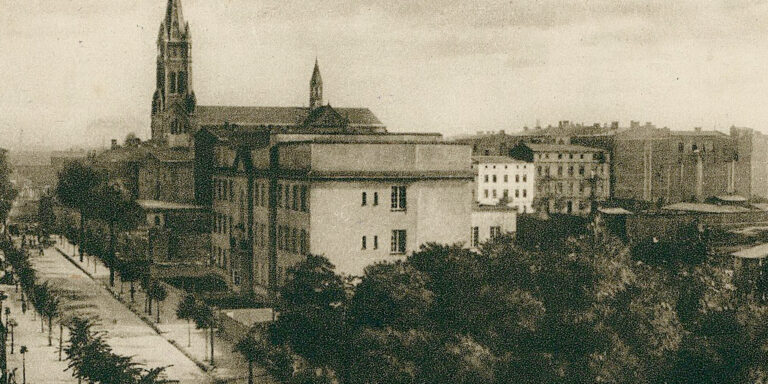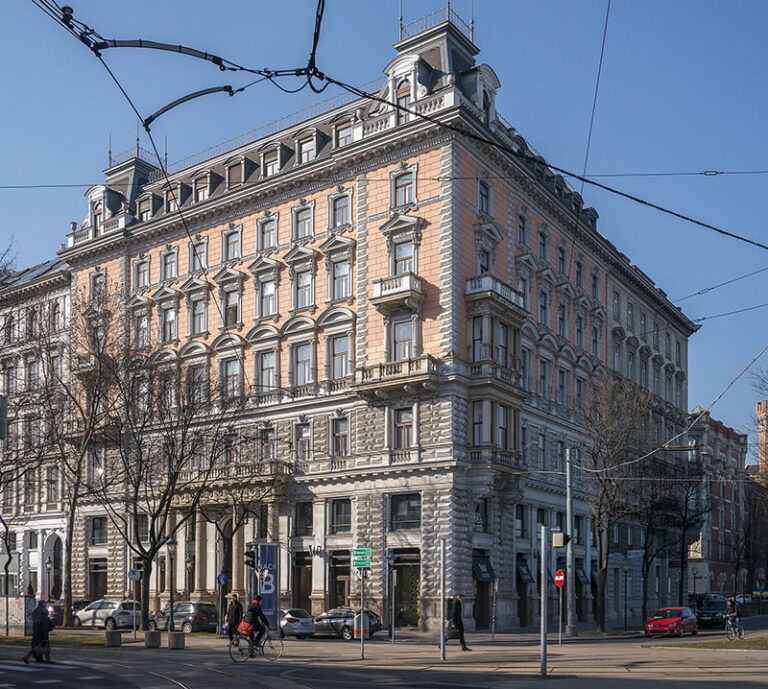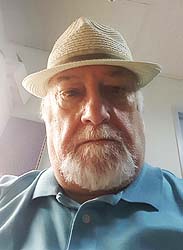 No Less Lost
No Less Lost
Grace Linden
Last year, I went searching for the architect behind Schottenring 35 in Vienna, a tall structure with big windows and ornate stonework that is grand in the late-19th-century way that has always struck me as beautiful. My grandfather once lived somewhere above the building’s elegant storefronts. This was his last address in Vienna before he left Austria for England and then the United States. He never saw his family again, and I have never seen this building in person, though I obtained Wilhelm Stiassny’s architectural plans with the help of Austria’s National Library.
What I will do with these plans, however, I haven’t yet determined. Probably nothing, if I am honest. Every day the past becomes fuzzier as the gap between what once was and what is grows. I am not sure what there is to learn or uncover. But then I think of my family, their lives and meals and gossip and weekends, and I go back to the email, retranslate the German, and imagine who filled this Küche, these Zimmers.
 Postcard of Sosnowiec from between 1925 and 1936. (Image via Wikicommons)
Postcard of Sosnowiec from between 1925 and 1936. (Image via Wikicommons)
The past can be exhilarating, and it can be quicksand. So discovers Menachem Kaiser in Plunder, his expansive, complicated, generous memoir. Like me, Kaiser too came to focus on a building. In 2010, on a research fellowship in Lithuania, he traveled to Krakow to celebrate Rosh Hashanah. He knew little of this part of his history except that his grandfather Maier Menachem Kajzer was the sole member of his family to have survived the Holocaust; he died before Kaiser was born. The stay in Krakow was Kaiser’s first visit to Poland and while there, he called his father to find out where Maier had grown up. From a stack of his grandfather’s old papers, an address was produced for a building in Sosnowiec, an industrial city in the Silesia region. It emerged that the building had not only been Maier’s home but was also owned by his family. After Maier immigrated to the United States, he sought compensation for the lost property, first from the Polish government and then through the United States’ Foreign Claims Settlement Commission, but bureaucratic tape, hefty fees, and translation problems doomed the claim.
Malachowskiego, the street on which the building is located, is now a busy thoroughfare. “What I felt most sharply standing there in front of my grandfather’s building was not a connection this place/time but a sense of discontinuity with the past,” he writes.
No matter how literary and metaphorical you wanted to get, this wasn’t my home. My grandparents had done everything they could to wipe away this history. And they’d succeeded, no? Despite being the son of two Poles, my father would consider the idea that he is Polish ludicrous. No longing had been passed down. No seeds of nostalgia had been planted.
Kaiser went to Sosnowiec because it was something to do and because in that city there existed a physical site with fixed coordinates to which he could anchor his past. Once he verified its existence, he left, never expecting to return.
He began, however, to travel more frequently to Poland, and, prodded by his father, he eventually looked at the documents his grandfather had assembled. Kaiser found himself “unexpectedly moved” by what he read, swept up by the struggle and the words in his grandfather’s handwriting. “I have never felt particularly disturbed by this legacy,” Kaiser writes,
but then I read the file, saw how my grandfather had tried and failed for more than twenty years to reclaim what his family had lost, and here was an opportunity, I thought, to allow myself to be disturbed.
Once, the Kajzer family (spelled Kajzer on the Polish documents) owned a building that they were forced to abandon. Maier lived, the rest were murdered, and the building was lost. Decades later, armed with evidence and an Americanized name, Kaiser would open himself to history;he would go to Poland and get the building back.
 A building on Schottenring, present day.
A building on Schottenring, present day.
Kaiser begins by hiring a lawyer, and together they optimistically plan a course of action. To prove his family has rights to the building, Kaiser must first confirm the deaths of his long-dead relatives, which shouldn’t be hard. These are people who, born at the end of the 19th century, could not be anything other than dead in 2016. A question of geography requires that his case be split between two jurisdictions: One judge agrees that yes, the relatives are indeed deceased, while the other rejects Kaiser’s motion. “The antagonist,” Kaiser learns, “was the process itself.” Upon learning that his great-great-grandparents cannot legally be declared dead, he writes:
The generosity I’d come to the process with, that spirit of what can you do, bureaucracies will be bureaucratic, now seemed so misplaced, so naïve. Because all I was asking for here, really, was an acknowledgment of a supremely banal fact, that they’re dead, that my relatives who died in the Holocaust are dead. What could be an easier-to-acknowledge truth?
The bureaucratic, Sisyphean struggle warps reality, and Kaiser’s story resists a straightforward, linear telling. He begins by telling it chronologically, but quickly the narrative overlaps and doubles back, owing in part to his incorporation of diary entries, poetry, and theoretical conversations and encounters.
This skewing is reflected in the landscape of Poland itself, where castles and crematoria abut suburban neighborhoods and Holocaust survivors drink tea with the treasure hunters searching for a buried Nazi hoard. The Holocaust may seem a discrete event, but that is far from the truth, a fact Kaiser is reminded of repeatedly as he encounters its many physical traces. Skeletal structures of concentration camps, hidden rooms in ordinary homes, the myth of the gold train—it all mars Poland’s land. Despite an increasingly autocratic government’s attempts to make it otherwise, the past is very much still present.
recommended by: Leon Rozenbaum
 Of the 3.3 million Jews that lived in Kaiser’s grandfather’s Poland prior to the war, only around 380,000 survived. Kaiser’s family is but one family in a sea of many families, all of whom lost so much. There is a lot of property to contend with and a lot of sadness. And a lot of life moved into these apartments and businesses. If successful in his claim, Kaiser (along with other members of his extended family) would become the new owner of 12 Malachowskiego, a prospect that understandably unnerves the building’s current occupants. Would their rents be raised, their apartments seized? Kaiser imagines the arguments they will bring against him:
Of the 3.3 million Jews that lived in Kaiser’s grandfather’s Poland prior to the war, only around 380,000 survived. Kaiser’s family is but one family in a sea of many families, all of whom lost so much. There is a lot of property to contend with and a lot of sadness. And a lot of life moved into these apartments and businesses. If successful in his claim, Kaiser (along with other members of his extended family) would become the new owner of 12 Malachowskiego, a prospect that understandably unnerves the building’s current occupants. Would their rents be raised, their apartments seized? Kaiser imagines the arguments they will bring against him:
Call it what you want, but the fact of the matter is that you don’t live here, your family doesn’t live here, no one in your family has lived in Sosnowiec for decades, and you don’t plan on living here, ever. You come to Poland for a couple of months a year, you’re really not much more than a glorified tourist, and you saw an opportunity to take—I’m sorry—to ‘assert ownership’ of this building. . . . This country did not stand still the past seventy years, waiting for you.
Kaiser spent most of his life oblivious to this building’s existence. While his family is entitled to what was stolen, the people who live in the apartments are also entitled to their lives.What seems a straightforward decision—go to Poland, file a claim—is far from simple, and Plunder is really about moral complexity any of making such a claim. In thinking it through, Kaiser often addresses his audience directly. His use of “you” and “we” is enveloping, compassionate. It is also conspiratorial, and the voice becomes steadily more confessional, almost frantic as the narrativeprogresses. “What matters here,” he writes, “is less the name on a deed than trying and failing but trying still to understand what it means to have, to lose, to take, to take back, to impose your legacy, to misread your legacy . . . to assume the role of the protagonist in a story that isn’t yours and that you can never understand.” Kaiser wants the building; he wants justice for his family, but from whom isn’t evident. “It is remarkable how long an act of violence can echo,”—and how loudly.
Restitution only gets trickier the more time elapses. Claims can take years if not decades to resolve and often not in favor of the claimant.Even the most famous cases are far from clear cut. In 1939, Lilly Cassirer was forced to sell a Camille Pissarro painting her family had owned for forty years to the Nazis in exchange for her family’s freedom. Unable to locate the painting after the war ended, they accepted $13,000 in reparations from the German government. Almost five decades later, that painting, Rue St.-Honoré, Après-Midi, effet de Pluie, was discovered hanging on the walls of the Museo Nacional Thyssen-Bornemisza in Madrid. The museum acquired the work in 1993, but it had changed hands many times before that. Thus began a legal battle that lasted more than a decade and ended with a ruling in favor of the museum. The painting is now valued at upwards of $40 million.
If it is difficult to reclaim a famous painting, which has the advantage of being unique and well documented, imagine the near impossibility of recovering more ordinary possessions. For every claim that has been resolved, countless others were denied or never brought forward as the threads that bound survivors to their belongings further frayed. What of a photo album, or a Torah, or a table? This is treasure too, and no less worthy and no less lost.
Each year tour guides ferry Jewish visitors to Europe to learn about their heritage. Across Latvia, Spain, the Czech Republic, they visit synagogues and cemeteries, hear from scholars, see where Kafka was born. Within these groups, there is often what Kaiser calls a “memory-tourist,” who aspires to unwind the past rather than merely visiting it. Guided by figments of stories and long-ago addresses, he hopes to answer the unanswerable.
If the first memory-tourists were those who actually experienced the horrors of World War II, increasingly it is their children and grandchildren who make such trips now. But the story of “the grandchild trekking back to the alte heim on his fraught memory-mission,” is one that Kaiser finds suspect, and rightfully so, even if it is also his story. His grandfather, who he never met, rarely discussed the war; neither did his parents. To go digging may lead to answers, but it also is an intrusion; few who do so ask if it is a mistake.
Kaiser had hoped this process would bring him closer to understanding his grandfather. Instead, he writes, “at every step [his] legacy seemed to retreat.” No amount of compensation can bring back a life, a family. “We do not continue their stories,” writes Kaiser, “we act upon them. We consecrate, and we plunder.”
Zawartość publikowanych artykułów i materiałów nie reprezentuje poglądów ani opinii Reunion’68,
ani też webmastera Blogu Reunion’68, chyba ze jest to wyraźnie zaznaczone.
Twoje uwagi, linki, własne artykuły lub wiadomości prześlij na adres:
webmaster@reunion68.com
